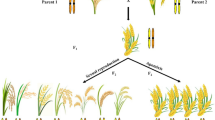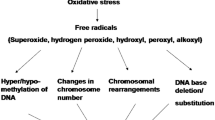Abstract
Rice male sterile (MS) lines, IR66707A and IR69700A, which possess the cytoplasm ofOryza perennis andO. glumaepatula respectively, belong to the cytoplasmic type. Their sterility could be maintained but not be restored. By somatic cell culture of these two MS lines, 47 somaclones with 465 R1 plants were obtained. All of the 465 R1 plants were sterile in the spring season in Guangzhou. According to the expression of the R1 plants and the level of similarity to their donor parents, they could be divided into three types. The plants of type I were male sterile. The sterility of some somaclones of this type could be restored by the test crossing varieties or alternated to fertile by changes of some environmental conditions. The hybrid F1 of test cross from the MS somaclones in type I was fertile while the hybrid F1 from the donor MS lines was still sterile. The R1 plants of type II were similar to the donor parents and also male sterile. The hybrid F1 from all of the plants of type II crossed to test variety were still sterile, so they did not possess restorability. For the somaclone of type III, all of R1 plants were sterile in both male and female organs. No seed was set in both conditions of self and cross pollination. The fact that the restorable variants obtained in the cytoplasmic type of MS lines of rice byin vitro culture reported here should be the first sample in somaclonal variation in plant kingdom.
Similar content being viewed by others
References
Yuan, L. P., Advantages and constraints to use of hybrid rice varieties, in Proceedings of the International Workshop on Apomixis in Rice (ed. Wilson, K. J.), New York and Beijing: The Rockefeller Foundation and China National Center for Biotechnology Development, 1993, 1–4.
Dalmacio, R., Brar, D. S., Ihi, I. T. et al., Identitication and transfer of a new cytoplasmic male sterility source hmOryza perennis into rice (O. sativa), Euphytica, 1995, 82: 221.
Dalmacio, R., Brar, D. S., Virmani, S. S. et al., Male sterile line in rice (Oryza sativa) developed withO. glumaepatula cytoplasm, IRRN, 1996, 21(1): 22.
Ling, D. H., Ma, Z. R., Chen, W. Y. et al., Male sterile mutant from somatic cell culture of rice. Theor, Appl. Genet., 1987, 75: 127.
Larkin, P. J., Scowcroft, W. R., Somaclonal variation—a novel source of variability from cell cultures for plant improvement, Theor. Appl. Genet., 1981, 60: 197.
Bertin, P., Boutharmont, J., Kinet, J. M., Somaclonal variation and improvement of chilling tolerance in rice: changes in chilling-induced chlorophyll fluorescence, Crop Sci., 1997, 37: 1727.
Yamagishi, M., Itoh, K., Shimamoto, K. et al., Characteristics of genetic variation in the progenies of protoplast-derived plants of rice,Oryza sativa cv Nipponbare, Thoer. Appl. Genet., 1997, 94: 1.
Ling, D. H., Somaclonal male sterile mutants and their expression in rice, in Rice Genetics II (ed. IRRI), Manila: IRRI, 1991, 295.
Ling, D. H.,In virro production of male sterile rice plants, in Biotechnology in Agriculture and Forestry, Vol. 36: Somaclonal Variation in Crop Improvement II (ed. Bajaj, Y. P. S.), Berlin, Heidelberg: Springer-Verlag, 1996, 20.
Author information
Authors and Affiliations
Corresponding author
About this article
Cite this article
Ling, D., Ma, Z. Restorable variation of cytoplasmic type of male sterile line in rice byin vitro culture. Chin. Sci. Bull. 45, 2246–2250 (2000). https://doi.org/10.1007/BF02886362
Received:
Issue Date:
DOI: https://doi.org/10.1007/BF02886362




